Mosquito Control, Reduction, and Prevention
In “Mosquito Prevention 101: How to Protect Yourself, Your Garden, and Your Home,” we delve into the comprehensive strategies required to combat the ubiquitous mosquito menace. From understanding their life cycle to deploying a variety of control and prevention tactics including source reduction, chemical interventions, natural predators, and personal protection measures, this article equips you with the knowledge to safeguard your environment against these persistent pests.
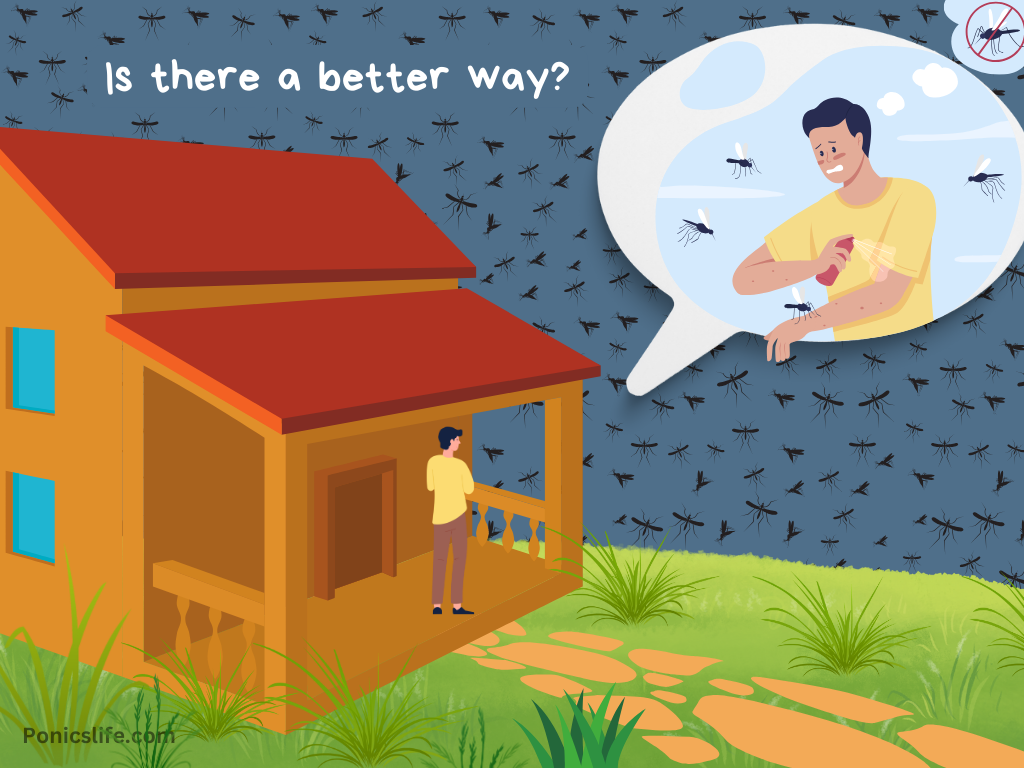
While control and reduction efforts focus on diminishing the existing mosquito population through methods like source reduction, larviciding, and introducing natural predators, prevention and repellent strategies are designed to deter mosquitoes from inhabiting spaces and biting humans. Control and reduction tackle the problem at its source—eliminating breeding grounds and actively reducing mosquito numbers—whereas prevention and repellents create barriers and deterrents to minimize human-mosquito encounters.
Together, these approaches form a comprehensive defense, addressing both the reduction of the mosquito population and the protection of individuals from bites, thereby reducing the risk of mosquito-borne diseases.
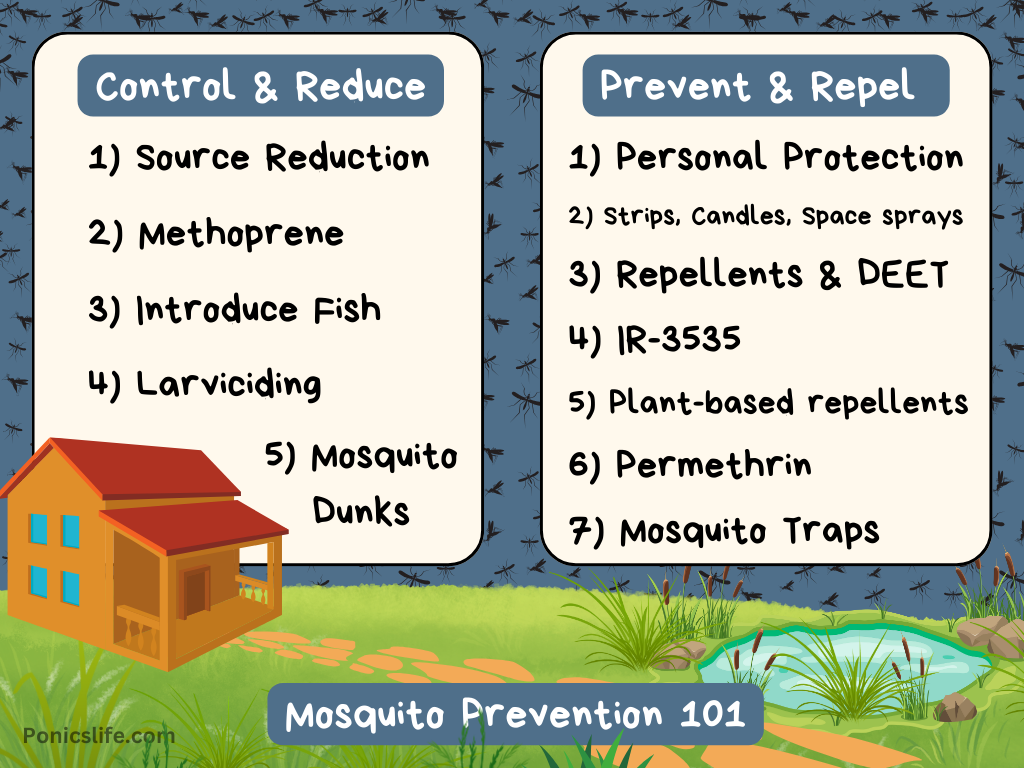
The Mosquito Life Cycle
The life cycle of a mosquito unfolds through four distinct stages: eggs, larvae, pupae, and adults, each critical for the mosquito’s development and survival. The journey begins when a female mosquito lays her eggs directly on or near water surfaces, which can include stagnant ponds, marshes, or even collected rainwater in artificial containers. These eggs, often laid in clusters known as rafts, hatch into larvae within 24 to 48 hours, depending on the species and environmental conditions, marking the first step in a mosquito’s life dependent on aquatic habitats.
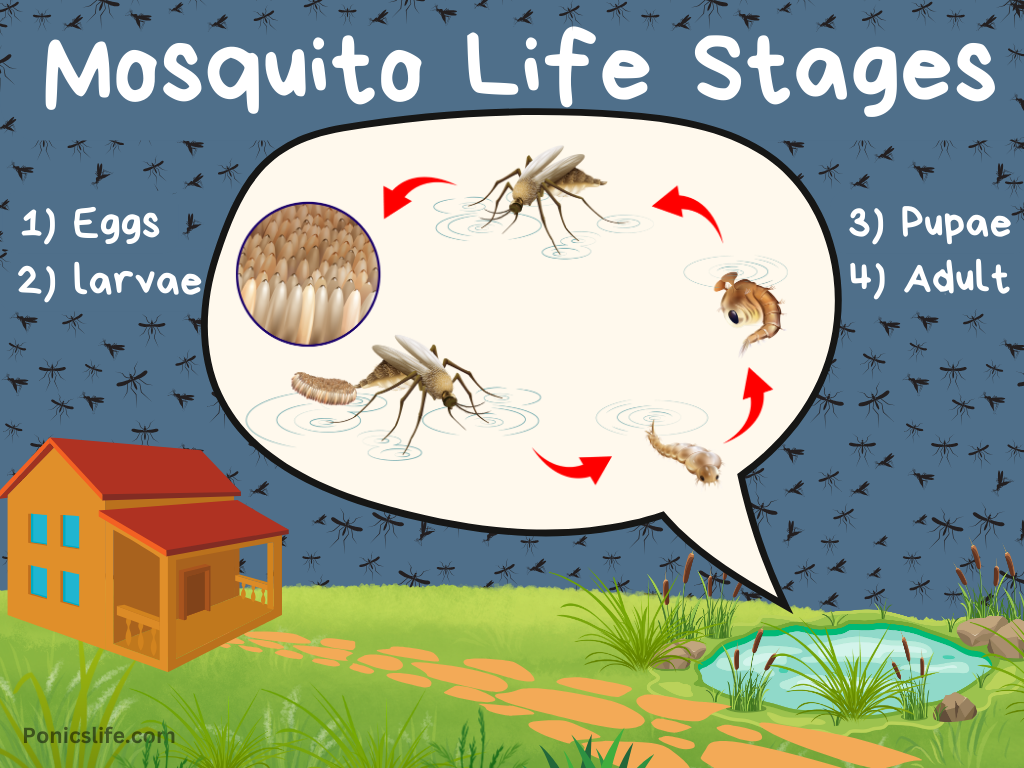
As larvae (also known as wigglers), mosquitoes live in the water, feeding on microorganisms and organic matter, where they breathe through siphons at the water’s surface. This larval stage, which can last from 5 to 14 days, is followed by the pupal stage, a non-feeding period during which the mosquito transforms into its adult form. The pupae, commonly referred to as tumblers due to their motion in the water, float on the surface for about two days before emerging as fully formed adults, ready to leave the aquatic environment and begin their life in the air, seeking blood meals to reproduce and continue the cycle.
How to Control and Reduce Mosquitoes
To effectively control and reduce mosquito populations, a multifaceted approach that combines source reduction, targeted chemical interventions, and natural predators is essential. By eliminating breeding grounds, employing larvicides and mosquito dunks, utilizing growth inhibitors like methoprene, and introducing mosquito-larvae-eating fish, we can significantly diminish the presence of these pests in our environments.
Source Reduction
Source reduction, a key strategy in mosquito control, involves the elimination or management of water sources where mosquitoes breed. By removing standing water from containers, unclogging gutters, and ensuring proper drainage in gardens and yards, homeowners can significantly reduce mosquito populations. This environmentally friendly approach not only minimizes the need for chemical repellents but also targets mosquitoes at their source, disrupting their life cycle and preventing future infestations.
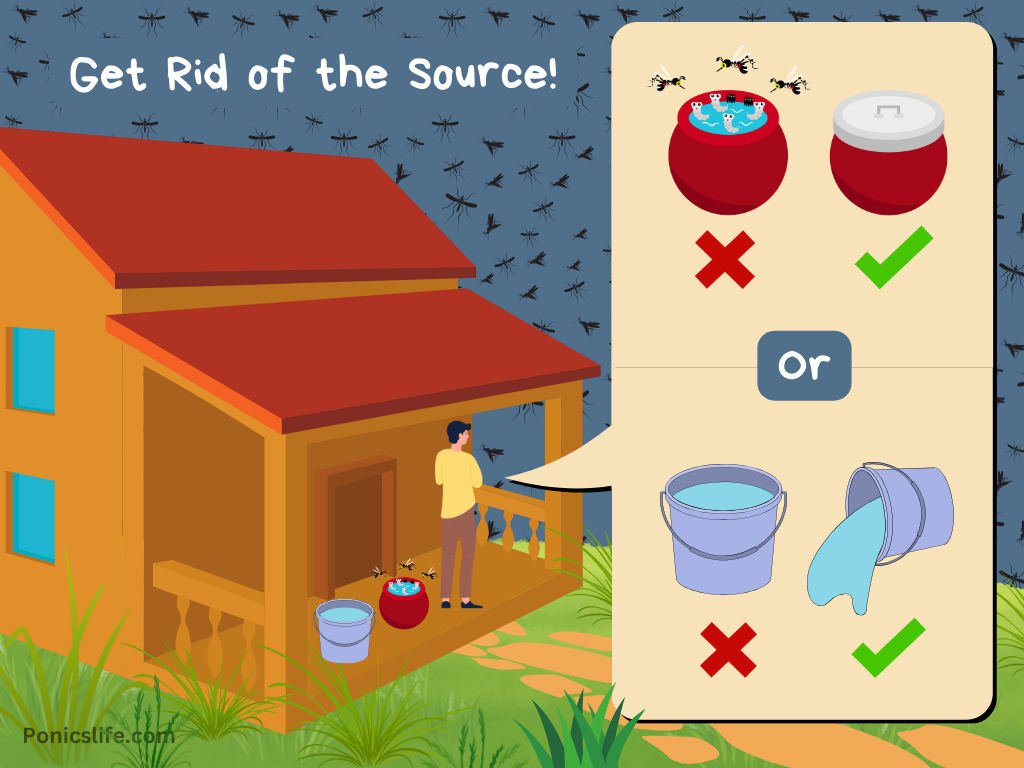
Source reduction measures include:
- Eliminate potential mosquito breeding sites by addressing standing water sources, such as puddles, uncovered water tanks, and leaky pipes, as well as removing items like unused tires.
- Remove all debris, including scrap metal, derelict vehicles, bottles, cans, and other refuse from residential areas.
- Address and rectify any depressions in the landscape that may collect and retain water, aiding long-term mosquito management.
- Encourage the presence of mosquito predators such as birds, frogs, lizards, and fish around your property.
- Securely cover all water storage containers to block mosquito access.
- Prevent the buildup of rotting waste and trash around living spaces to avoid attracting mosquitoes.
- Maintain clean and unclogged roof gutters to prevent water pooling.
- Regularly drain and refresh water in containers used by pets and for wildlife, like bird baths and troughs, on a weekly basis.
- Ensure tire swings have drainage holes to avoid water retention.
- Seal tree cavities with mortar to prevent water accumulation.
Larviciding
Larviciding is a targeted approach in mosquito control that involves applying pesticides to water sources where mosquito larvae are present. This method aims to eliminate mosquitoes in their larval stage before they can mature into biting adults, effectively reducing the population. Safe for the environment when used correctly, larvicides come in various forms, including liquids, granules, and tablets, and are crucial for interrupting the mosquito life cycle in infested areas.
- Larviciding is one of the most common mosquito control methods.
- Only larvicide areas where standing water cannot be eliminated.
- Safest larvicides include methoprene products and Bti (Bacillus thuringiensis israelensis) products.
Mosquito Dunks
Mosquito dunks are a form of larvicide shaped like small donuts, designed to be placed in bodies of standing water to combat mosquito larvae. Comprised of Bacillus thuringiensis israelensis (Bti), a naturally occurring bacterium that is lethal to mosquito larvae but safe for humans, pets, and wildlife, these dunks offer a targeted, eco-friendly solution to mosquito infestation. Once deployed, they gradually dissolve over a period of 30 days or more, releasing the bacterium that specifically targets and kills the larvae, thereby preventing the emergence of adult mosquitoes.
- Can be used anywhere with standing water.
- Sold as Mosquito Dunks® and Mosquito Bits™ with the bits offering faster control.
- The package includes the amount of bits/number of dunks to use.
Methoprene
Methoprene is an insect growth regulator (IGR) used in mosquito control programs to interrupt the development of mosquito larvae, preventing them from maturing into breeding, biting adults. Structurally similar to a hormone in mosquitoes, it works by mimicking these natural growth hormones, leading to lethal abnormalities in the larvae or pupae stages. Safe for use around humans and non-target wildlife when applied correctly, methoprene is versatile, being effective in both standing water environments and as part of integrated pest management strategies to combat mosquito populations.
- Up to 21 days of control.
- Because older larvae and pupae don’t eat, it is only effective at the beginning of a mosquito’s life cycle.
- Important that the directions (on the product) are followed so that the pesticide is used appropriately.
Use Fish
Introducing fish species that feed on mosquito larvae into ponds, water gardens, and other stagnant water bodies is an environmentally friendly method of mosquito control. Fish such as Gambusia affinis (mosquitofish), certain types of minnows, and guppies naturally prey on mosquito larvae, significantly reducing the mosquito population without the need for chemical interventions. This biological control strategy not only helps in managing mosquito populations effectively but also promotes biodiversity and maintains the ecological balance of aquatic habitats.
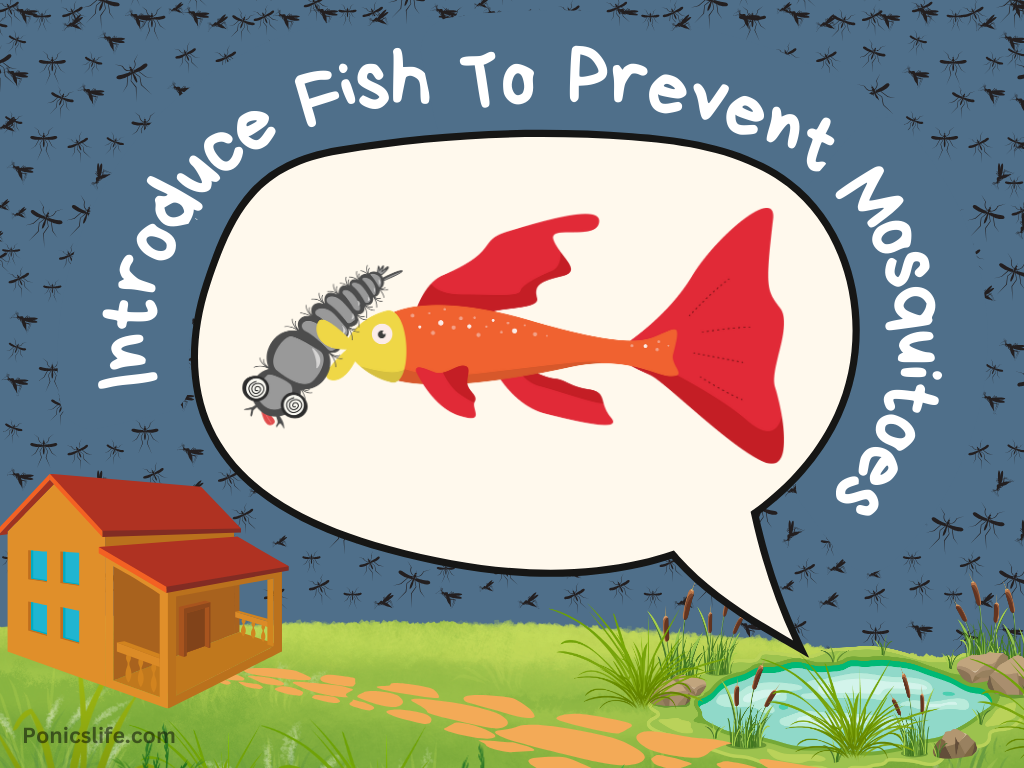
- While any fish will eat mosquito larvae, the Mosquito fish (Gambusia affinis) is the hardiest and is very tolerant of poor water conditions.
- The Mosquito fish (Gambusia affinis) can feed off pond vegetation and doesn’t need to be fed, making it a hands-off approach.
How to Prevent and Repel Mosquitoes
To prevent and repel mosquitoes, adopting a comprehensive approach that blends environmental management, personal protection, and the strategic use of repellents and traps is key. From the careful selection of mosquito-repelling plants in your garden to the application of effective skin and clothing treatments, along with the deployment of innovative trapping mechanisms, each strategy plays a crucial role in reducing the mosquito population and minimizing their impact on our health and comfort.
Personal Protective Measures
Personal protection measures against mosquitoes are crucial in preventing bites and the diseases they may carry. Wearing long-sleeved shirts and pants, using mosquito nets, and avoiding the outdoors during peak biting hours (from dusk to dawn), can greatly reduce the risk of mosquito bites. Additionally, installing screens on windows and doors and using air conditioning can help keep mosquitoes out of indoor living spaces, further safeguarding individuals and families from these persistent pests.
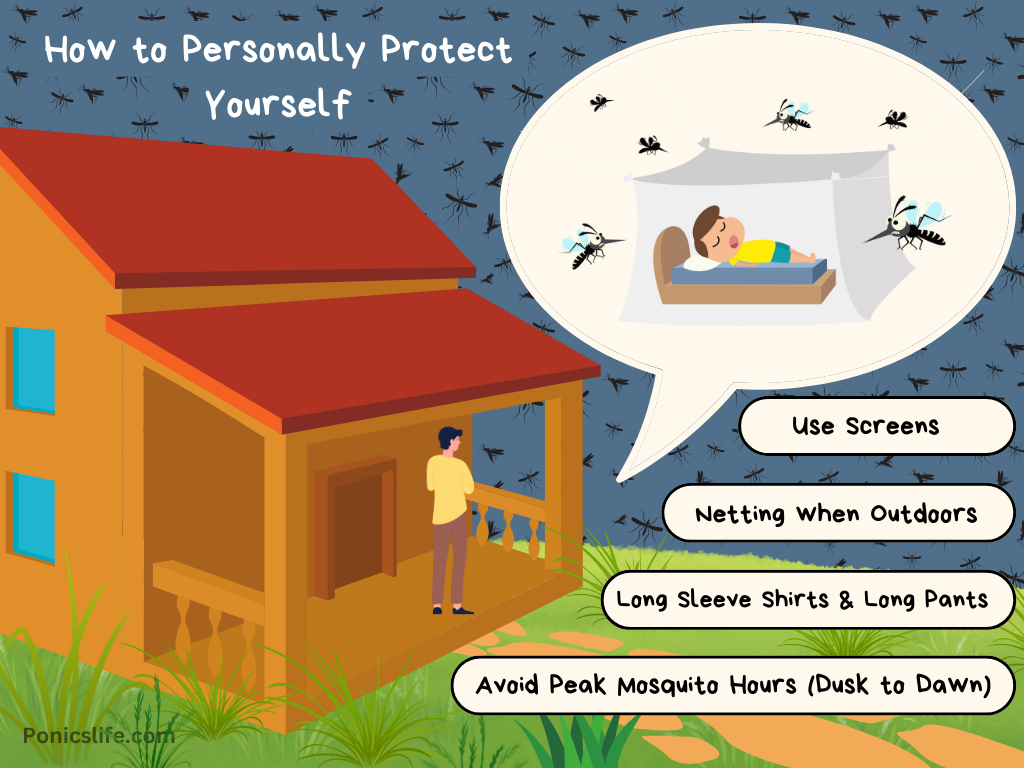
- Always cover up exposed skin where possible.
- Use bednets or tents when camping or sleeping outdoors.
- Try to avoid going outside during peak biting hours (dusk to dawn).
- Use wire screens on the outside of windows and other entry points into your house.
Strips, Candles, and Space Sprays
Mosquito control can also be enhanced through the use of strips, candles, and space sprays, each offering a different method of deterring or killing mosquitoes in specific areas. Mosquito strips, which release insecticide gradually over time, can be placed in outdoor areas to reduce mosquito presence. Candles and torches containing citronella or other natural oils can provide a temporary protective barrier against mosquitoes, making them ideal for patios and outdoor gatherings. Space sprays, whether manually applied aerosols or automated misting systems, disperse insecticides into the air to quickly knock down mosquito populations, offering immediate relief in infested areas. These tools, when used as part of a comprehensive mosquito management plan, can significantly enhance personal protection and comfort in mosquito-prone environments.
- Always check the label before spraying. If it says indoors, only use it inside. If it says outdoors, only use it outside.
- If the label does not mention mosquitoes, it is probably ineffective against them.
- Note that citronella candles and incense usually offer the same level of protection.
Using Deet and Repellents
DEET, a powerful chemical repellent, has been widely recognized for its effectiveness in providing long-lasting protection against mosquito bites. When applied to exposed skin or clothing, DEET works by interfering with the receptors mosquitoes use to detect carbon dioxide and skin odors, making it harder for these pests to land and bite. Alongside DEET, there are other repellents containing ingredients like picaridin, IR3535, or plant-based oils such as oil of lemon eucalyptus, which offer varying levels of protection and are options for individuals seeking alternatives to DEET. These repellents play a crucial role in personal preventive strategies against mosquitoes, significantly reducing the risk of mosquito-borne diseases.
- Always read and follow the label when applying DEET products.
- Children should only use products between 10% and 30% DEET.
- Important to wash (self and clothes) after using DEET.
IR-3535
IR-3535, ethyl butylacetylaminopropionate, is a synthetic amino acid that serves as an effective insect repellent, providing protection against a wide range of biting insects, including mosquitoes, ticks, and flies. Recognized for its safety and efficacy, IR-3535 is often included in repellent formulations applied directly to the skin or clothing. Its gentle nature makes it suitable for family use, offering long-lasting protection that is comparable to other leading repellent compounds such as DEET and picaridin, without the harshness, making it a preferred choice for those with sensitive skin or looking for a less aggressive scent.
Using Plant-based Repellents
Plant-based repellents offer a natural alternative to synthetic chemicals for deterring mosquitoes, with ingredients derived from essential oils of plants known for their insect-repelling properties. Commonly used essential oils include citronella, lemongrass, eucalyptus, and peppermint, each providing a degree of protection against mosquito bites. These natural repellents are particularly appealing to those seeking eco-friendly and potentially less irritating options for personal mosquito protection, although their effectiveness may vary and typically requires more frequent application compared to synthetic repellents.
Permethrin
Permethrin is a synthetic chemical that acts as an insecticide and repellent, widely used in public health and personal protection against mosquitoes and other pests. Though not applied directly to the skin, permethrin is used to treat clothing, gear, and fabrics, where it binds tightly to the fibers, providing long-lasting protection that can withstand multiple washes. Its effectiveness in repelling and killing mosquitoes makes it a vital component in the fight against mosquito-borne diseases, offering an additional layer of defense when combined with skin-applied repellents for outdoor activities in mosquito-infested areas.
Mosquito Traps
Mosquito traps are designed to attract, capture, and kill mosquitoes, employing various strategies to mimic the cues mosquitoes seek, such as carbon dioxide, heat, light, and chemical attractants that mimic human or animal scent. These devices can significantly reduce the local mosquito population by luring adult mosquitoes away from people and trapping them before they have a chance to bite. Efficient in both indoor and outdoor settings, mosquito traps serve as a strategic tool in integrated pest management, offering a non-toxic way to diminish mosquito numbers and potentially lower the risk of mosquito-borne diseases in the area.
- Mosquito traps are promising and evolving, but still shouldn’t be relied on as a sole mosquito eliminator.
Gardening Considerations
Gardening can play a pivotal role in mosquito control through thoughtful landscaping and the selection of plants that naturally repel mosquitoes. Incorporating plants such as citronella, lavender, marigolds, and basil into your garden not only adds beauty and fragrance but also can deter mosquitoes with their natural oils. Additionally, managing water effectively by ensuring proper drainage, avoiding water stagnation in pots, and maintaining ponds or water features to encourage natural predators like fish can significantly reduce mosquito breeding sites. These gardening practices contribute to a healthier, more enjoyable outdoor living space, minimizing the reliance on chemical repellents and fostering a natural ecosystem balance.
FAQs
Where did this information come from?
To create this article, we primarily used information from the Mississippi State Department of Health.
Is Mosquito control and prevention relevant to hydroponics?
If growing outside, mosquitoes can find hydroponic systems attractive due to the presence of standing water, which provides an ideal breeding ground for their larvae. To prevent infestations in hydroponic setups, it’s crucial to cover water reservoirs, employ mosquito dunks that are safe for plants, and ensure proper water circulation to deter mosquito laying activity. Implementing these measures can help maintain a healthy hydroponic garden by minimizing the risk of mosquitoes without compromising the quality or safety of the plants.
How often should I replace mosquito dunks in standing water?
Mosquito dunks typically last for 30 days in standing water. It’s recommended to replace them every month during the mosquito season to ensure continuous protection.
Are there any natural predators I can introduce to my garden to help control mosquito populations?
Yes, besides fish like Gambusia affinis, you can attract birds, bats, and dragonflies, which are natural predators of mosquitoes. Installing bird baths, birdhouses, and bat houses can help attract these beneficial creatures to your garden.
Can essential oils be used as effective mosquito repellents?
Essential oils such as citronella, eucalyptus, and lavender have mosquito-repelling properties. However, their effectiveness varies, and they often need to be reapplied more frequently than synthetic repellents. They can be a good option for those seeking natural alternatives.
How can I make my yard less attractive to mosquitoes?
Maintain your yard by mowing the lawn regularly, trimming shrubs, and eliminating standing water in containers, tires, or pots. This reduces breeding sites and resting places for mosquitoes.
Are mosquito repellent plants effective?
Plants like citronella, lavender, and marigolds can help repel mosquitoes to some extent due to their natural oils. However, their effectiveness is limited to the immediate area around the plant, so they should be used in conjunction with other control methods for best results.
How does water management help in mosquito control?
Proper water management involves eliminating standing water (breeding sites) and ensuring water bodies are moving or stocked with natural predators. This reduces mosquito larvae’s chances of survival and development into adults.
What are the peak biting hours for mosquitoes?
Mosquitoes are most active during dawn and dusk. Avoiding outdoor activities or taking preventive measures during these times can significantly reduce the chances of getting bitten.
How can community efforts amplify mosquito control success?
Community-wide efforts, such as clean-up days to remove trash and standing water, can greatly reduce mosquito breeding sites in a neighborhood. Public education on personal protection and yard maintenance also plays a critical role in reducing the overall mosquito population.






